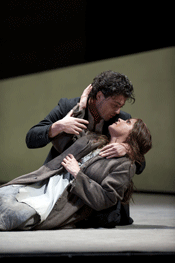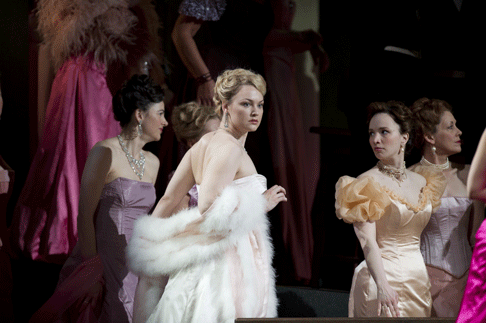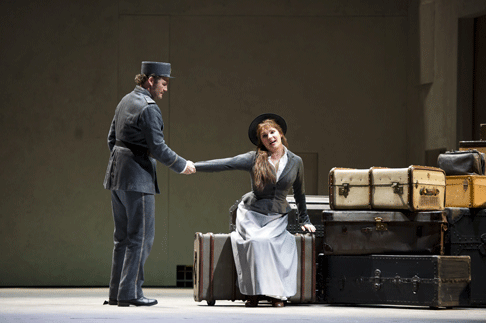![Anna Netrebko as Manon Lescaut [Photo by Bill Cooper courtesy of Royal Opera]](http://www.operatoday.com/MANON-BC201006160306-NETREB.gif)
04 Jul 2010
London’s Manon: Diva and Divo Deliver
The Royal Opera's intriguingly staged Manon had all the trappings of success including a soprano at the top of her game, and a tenor on the brink of his fame.
English Touring Opera are delighted to announce a season of lyric monodramas to tour nationally from October to December. The season features music for solo singer and piano by Argento, Britten, Tippett and Shostakovich with a bold and inventive approach to making opera during social distancing.
This tenth of ten Live from London concerts was in fact a recorded live performance from California. It was no less enjoyable for that, and it was also uplifting to learn that this wasn’t in fact the ‘last’ LfL event that we will be able to enjoy, courtesy of VOCES8 and their fellow vocal ensembles (more below …).
Ever since Wigmore Hall announced their superb series of autumn concerts, all streamed live and available free of charge, I’d been looking forward to this song recital by Ian Bostridge and Imogen Cooper.
Although Stile Antico’s programme article for their Live from London recital introduced their selection from the many treasures of the English Renaissance in the context of the theological debates and upheavals of the Tudor and Elizabethan years, their performance was more evocative of private chamber music than of public liturgy.
Evidently, face masks don’t stifle appreciative “Bravo!”s. And, reducing audience numbers doesn’t lower the volume of such acclamations. For, the audience at Wigmore Hall gave soprano Elizabeth Llewellyn and pianist Simon Lepper a greatly deserved warm reception and hearty response following this lunchtime recital of late-Romantic song.
For this week’s Live from London vocal recital we moved from the home of VOCES8, St Anne and St Agnes in the City of London, to Kings Place, where The Sixteen - who have been associate artists at the venue for some time - presented a programme of music and words bound together by the theme of ‘reflection’.
'Such is your divine Disposation that both you excellently understand, and royally entertaine the Exercise of Musicke.’
‘And there was war in heaven: Michael and his angels fought against the dragon; and the dragon fought and his angels, And prevailed not; neither was their place found any more in heaven … that old serpent … Satan, which deceiveth the whole world: he was cast out into the earth, and his angels were cast out with him.’
There was never any doubt that the fifth of the twelve Met Stars Live in Concert broadcasts was going to be a palpably intense and vivid event, as well as a musically stunning and theatrically enervating experience.
‘Love’ was the theme for this Live from London performance by Apollo5. Given the complexity and diversity of that human emotion, and Apollo5’s reputation for versatility and diverse repertoire, ranging from Renaissance choral music to jazz, from contemporary classical works to popular song, it was no surprise that their programme spanned 500 years and several musical styles.
The Academy of St Martin in the Fields have titled their autumn series of eight concerts - which are taking place at 5pm and 7.30pm on two Saturdays each month at their home venue in Trafalgar Square, and being filmed for streaming the following Thursday - ‘re:connect’.
The London Symphony Orchestra opened their Autumn 2020 season with a homage to Oliver Knussen, who died at the age of 66 in July 2018. The programme traced a national musical lineage through the twentieth century, from Britten to Knussen, on to Mark-Anthony Turnage, and entwining the LSO and Rattle too.
With the Live from London digital vocal festival entering the second half of the series, the festival’s host, VOCES8, returned to their home at St Annes and St Agnes in the City of London to present a sequence of ‘Choral Dances’ - vocal music inspired by dance, embracing diverse genres from the Renaissance madrigal to swing jazz.
Just a few unison string wriggles from the opening of Mozart’s overture to Le nozze di Figaro are enough to make any opera-lover perch on the edge of their seat, in excited anticipation of the drama in music to come, so there could be no other curtain-raiser for this Gala Concert at the Royal Opera House, the latest instalment from ‘their House’ to ‘our houses’.
"Before the ending of the day, creator of all things, we pray that, with your accustomed mercy, you may watch over us."
The doors at The Metropolitan Opera will not open to live audiences until 2021 at the earliest, and the likelihood of normal operatic life resuming in cities around the world looks but a distant dream at present. But, while we may not be invited from our homes into the opera house for some time yet, with its free daily screenings of past productions and its pay-per-view Met Stars Live in Concert series, the Met continues to bring opera into our homes.
Music-making at this year’s Grange Festival Opera may have fallen silent in June and July, but the country house and extensive grounds of The Grange provided an ideal setting for a weekend of twelve specially conceived ‘promenade’ performances encompassing music and dance.
There’s a “slide of harmony” and “all the bones leave your body at that moment and you collapse to the floor, it’s so extraordinary.”
“Music for a while, shall all your cares beguile.”
The hum of bees rising from myriad scented blooms; gentle strains of birdsong; the cheerful chatter of picnickers beside a still lake; decorous thwacks of leather on willow; song and music floating through the warm evening air.
![Anna Netrebko as Manon Lescaut [Photo by Bill Cooper courtesy of Royal Opera]](http://www.operatoday.com/MANON-BC201006160306-NETREB.gif)
The Royal Opera's intriguingly staged Manon had all the trappings of success including a soprano at the top of her game, and a tenor on the brink of his fame.
For his world class account of the Chevalier, young Vittorio Grigolo was lavished with the sort of reception being afforded to World Cup soccer goals these days. And what’s more, he kept on scoring and scoring and scoring and scoring all night. My fine impression of Mr. Grigolo in Zurich’s Il Corsaro did not in any way prepare me for his ability to totally immerse himself in such a thrilling, impassioned performance. From his first two acts of unforced boyish, puppy dog sincerity through his maturation and final extra-musical cry of despair over his beloved’s corpse, there was no detail of the character’s conflicts that he did not beautifully, effortlessly encompass.
He also showed that his lovely lyric voice could fill a larger house like Covent Garden. While I still would hope that he carefully consider spending too much vocal capital on the bigger outbursts, there is no denying that they were exciting. Vittorio seems to have a very secure technique, good vocal health, and an uncanny sense of how to use his gifts to good musical ends. His sotto voce effects were wonderfully calibrated and had us leaning forward in our seats to catch every nuance. And he is movie star handsome, a PR director’s dream. The rowdy approval from the discerning London public is a good indicator that Mr. G’s musical future is assured. Indeed, he made a pretty damn good case for calling the piece Des Grieux.
 Vittorio Grigolo as Chevalier Des Grieux and Anna Netrebko as Manon Lescaut
Vittorio Grigolo as Chevalier Des Grieux and Anna Netrebko as Manon Lescaut
But it is, in fact, named for its heroine and here we were equally fortunate to have superstar Anna Netrebko as Manon. That she puts the ‘G’ in Glamor, and that her well known soprano is one of the most sleek and lustrous in the lirico-spinto Fach goes without saying. Ms. Netrebko is occasionally less acclaimed for her dramatic conviction and specificity. Not so here, for her multi-faceted embodiment of this complex woman, and the sustained arc of the character’s journey are easily the best performance I have ever experienced from Anna. And her French was notably improved (nay, ‘good’!) from the ‘Frussian’ she was intoning (albeit beautifully) on Vienna’s recent Carmen telecast.
She was utterly believable as the unforced, eager, impressionable young girl who stumbled into Act I, and she grew from that foundation with strength and conviction. Moreover, she and her leading man had an infectious chemistry that must have communicated to the last row of seats in the amphitheatre and several blocks beyond. Her singing showed off all the usual strengths: soaring top notes, even production, especially good legato, heartfelt coloring. She does miss a pitch by a hair here and there, mostly at the end of phrases in the lower middle, but this is as unpredictable and curious as it is infrequent. The celebrated exponent of the role, Beverly Sills often joked that the heroine is ‘the French Isolde.’ And so it is, requiring vocal stamina, style from girlish charm to fated desperation, and un-ebbing star quality to carry the long-ish evening. Ms. Netrebko’s fame and marketability may precede her, but she has emphatically delivered on her promise with this immensely satisfying portrayal.
Russell Braun was a vigorous, swaggering Lescaut, and although he deployed his pleasing baritone securely (and with excellent diction) I felt his hectoring might be tempered with a bit of restraint. As the Count des Grieux, Christof Fishesser had noble bearing and his rich bass made the most of every phrase. Christoph Mortagne’s Guillot was unusually fine, characterized by wit and vivacity, cleanly sung, and cliche-free. It was a pleasure to encounter the wonderful baritone William Shimmel again, this time as a solidly voiced Brétigny. I don’t always pay much attention to the trio of coquettes (who I usually find as interchangeable as the Pointer Sisters), but on this occasion we were treated to distinctive performances by Louise Innes (Rosette), and two Jette Parker Young Artists: Kai Rüütel (Rosette) and especially the very promising Simona Mihai (Pousette). These three young ladies made vibrant contributions all evening, and particularly brightened the Casino scene.
 Kai Rüütel as Rosette and Simona Mihai as Poussette
Kai Rüütel as Rosette and Simona Mihai as Poussette
The gifted director Laurent Pelly deployed his usual arsenal of theatrical inventions and infused this Manon with more humor than usual,. This strategy paid off huge dividends when we got to the contrasting devastating emotional moments. Mr. Pelly is reliably a master of character development, resulting in every person on the stage (including choristers) being at all times engaged, committed to the moment, and buoyed by sub-text. His staging made excellent use of the various playing spaces, and it was executed to a fare-thee-well by the lively cast. I loved the men in tails, side-stepping across stage during the gavotte, like Fred Astaire’s group-courting their Ginger.
I was less taken with the look of the sets, although pleased overall with their functionality. Even when they seemingly doomed the action to unavoidably repetitive movement patterns, Laurent found a way to turn the limitations to an advantage. Never off-putting and well constructed, designer Chantal Thomas relied on spare-looking, angular lines for the most part. Amiens’ square was a white box of an affair with a long staircase to the top level surmounted by miniature boxy, shuttered and roofed ‘houses.’ Not much about it to convey the feel of the Belle Epoque. In fact, the look was quite at odds with the style of the aural goings-on. The director borrowed a staging trick from Birgit Nilsson who, approaching a high note that would scare normal sopranos motionless, would nail it and then run across the stage while holding it perfectly. On the last long held note of their duet, this Love Couple ran up the entire length of the stairs to escape off the upper platform, never faltering vocally. Ah, youth!
Act II was among the best overall settings of the night, with the garret perched atop a configuration of metal roofs on the stage floor, reached by an ‘L’ of a staircase broken by a landing. This was a very fine environment indeed for the plot’s requirements, which put Lescaut and the Chevalier in the room behind a closed door, with Manon and Brétigny on the lower level of the landing. Adieu, notre petite table is very effectively stage with the soprano opening the door to see the table in the far corner just as she begins, entering the room as she continues, and with meaningful moves gets back out the door to close it again with finality on ‘Adieu.’ This could be a Masters Class in staging an aria.
 Russell Braun as Lescaut and Anna Netrebko as Manon Lescaut
Russell Braun as Lescaut and Anna Netrebko as Manon Lescaut
The cement ramps of the Cours-La-Reine scene had little visual appeal, but were redeemed by lovely globed street lights and a pastel backdrop that included a hazy tease of a Ferris wheel. The design knockout of the night was arguably Anna’s dazzling — there is no other word for it — dazzling fur-trimmed pink gown. Indeed, the colorful, eye-pleasing costumes that Mr. Pelly designed with an assist from Jean-Jacques Delmotte saved the day as far as visual delights. Lionel Hoche devised rather predictable choreography for the ballet, well-performed by eight-count-’em-eight white tu-tu’d ballerinas (ballerini?). The girls seemed to be having much more fun squealing and being pursued by the tipsy, horny revelers at scene’s end.
With the St. Sulpice scene, designer and director devised the most completely realized bit of Massenet all evening. Rows of wooden chairs find the congregation of women facing the altar off left, that is when they are not rubber-necking to catch a glimpse of that hot young Father Vittorio lurking behind them. Down right, hidden by a divider is the seminarian’s bed and simple study. By the time Manon enters in a white satin gown and methodically lures him to his fate, we are back to horizontal mode faster than you can say N’est-ce plus ma main. She lustily tears open the top of his cassock baring his torso, and the two of them fumble their way through foreplay in (*gasp*) church, before the curtain falls not a moment too soon! Not since Sherrill Milnes tore open his robe in the Met Thais have so many binocs been raised in hasty unison. If there is ever a sexier opera scene than this, it will end up on X-Tube. (The moody, apt lighting design is courtesy of Joël Adam.)
As we then see-sawed our way scenically back to the angled platforms, the skewed perspective, the flat uni-set color (this time dark green) of the Hôtel de Transylvanie with its gambling tables that rolled on and off from the wings, I wondered if I was missing some sort of intentional alternating design pattern, one all blunt angles, one more realistic. Save one fun effect of wheeling on a table with Guillot seated on the end of it, the scene was competent but colorless (always excepting the attire). This was compensated for in large measure by the final scene, a beautiful, golden-beige open space flanked by receding bannisters on either side suggesting a desolate beach or quay more than the road to Le Havre. The street lamps on stage right recall the happier events of the Cours-la-Reine. It is with this final encounter that Pelly delivers his most heartfelt work with an inevitability about the final pairing and sinking and kissing and expiring that I will number among the tenderest extended moments ever communicated on an opera stage. Goose bumps. Tears. All the buttons were pushed. Bravi, tutti.
In the pit, Antonio Pappano’s conducting at first seemed dry, with a prelude of precision but not much joy. Maestro Pappano is a no fuss, no muss guy, and after a quick acknowledgment of the audience, he plunges right into the proceedings. And I mean, right in. Maybe allowing just a moment for the orchestra to focus on his face rather than his back would prep them a bit more for the bubbling opening bars. This was quickly remedied, and in short order everything was percolating along in festive Gallic fashion, but when the same music opened Act III, there was a noticeable difference in the style and elan from this fine group of musicians. Throughout the night, Pappano displayed total command, and accommodated and supported his well-rehearsed cast of singers.
James Sohre